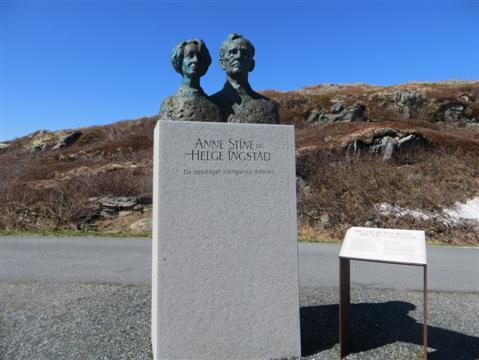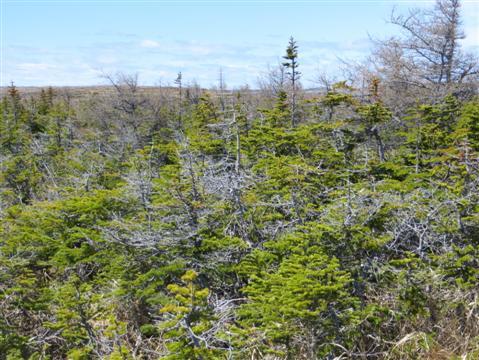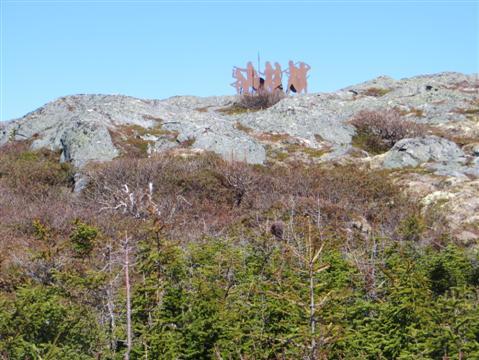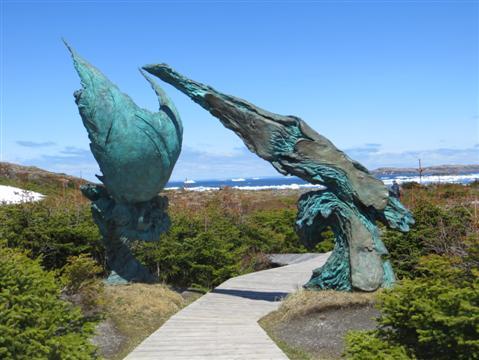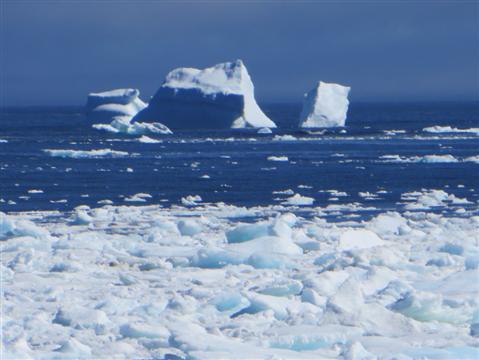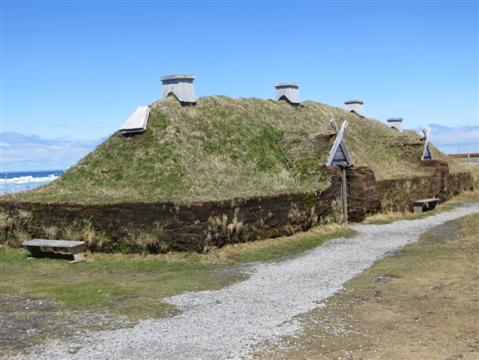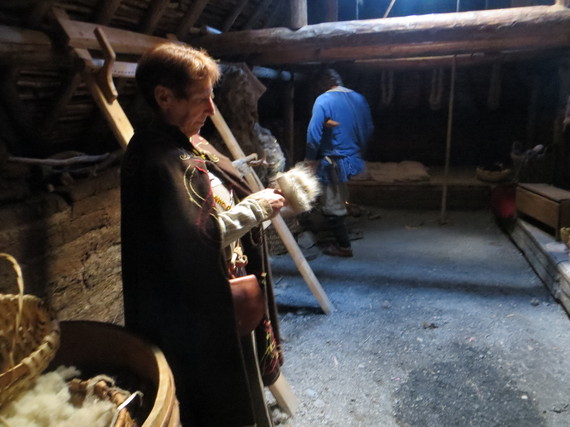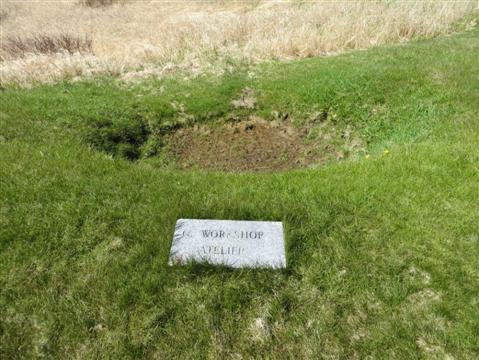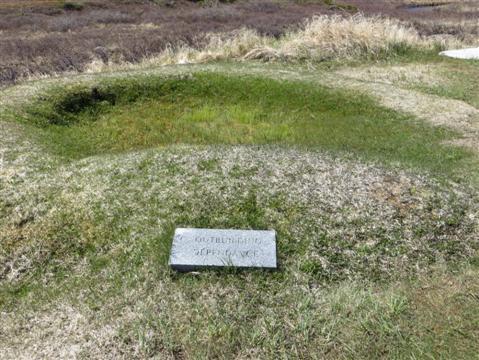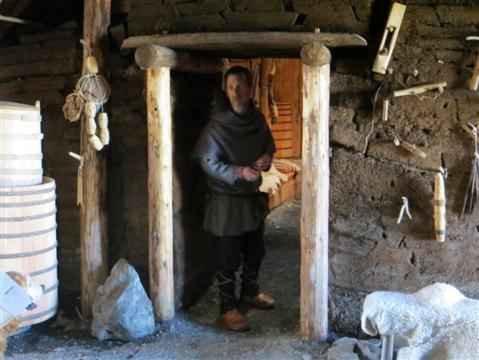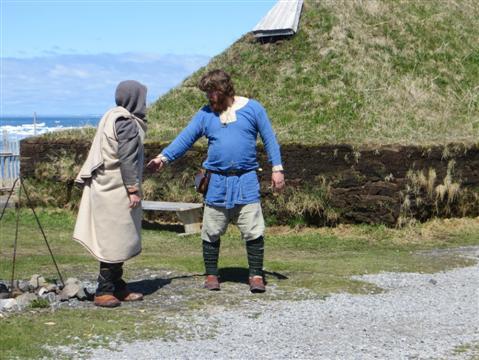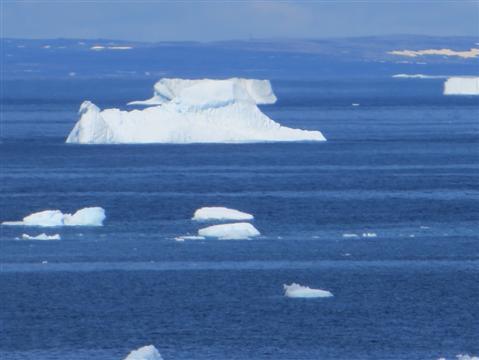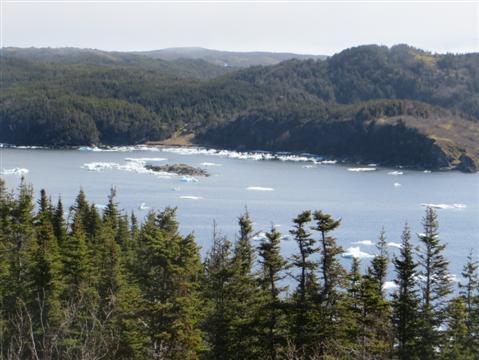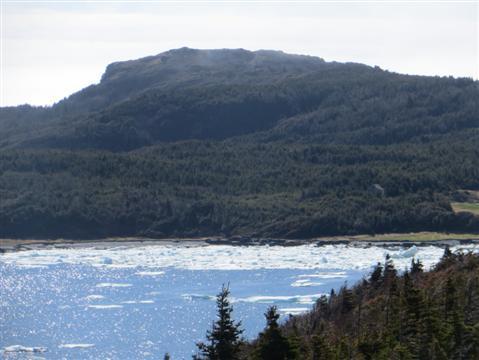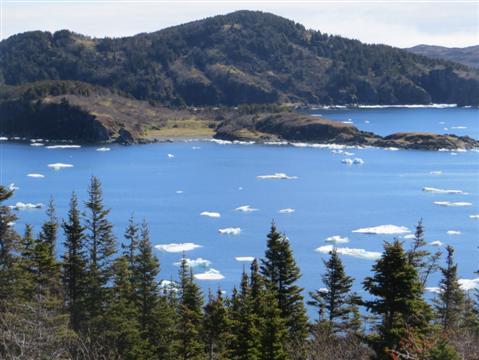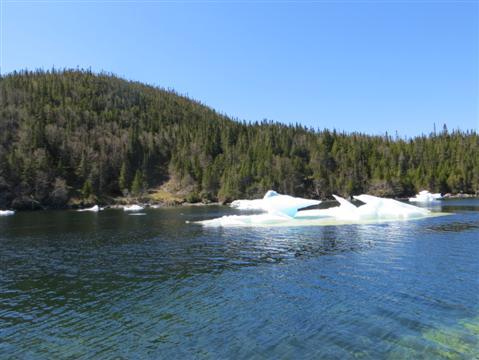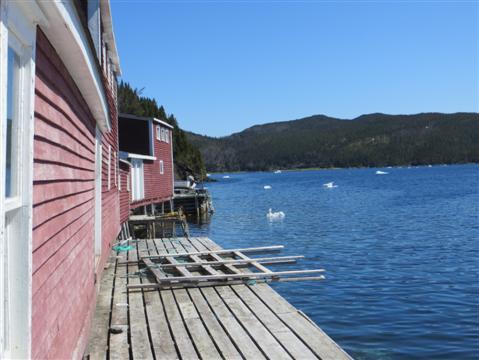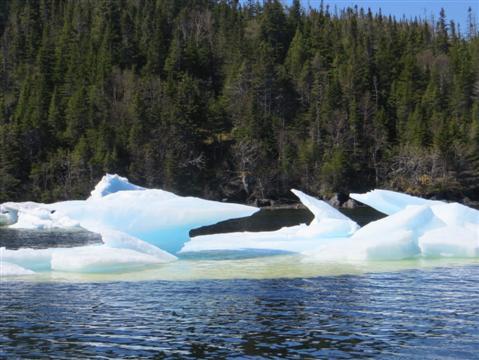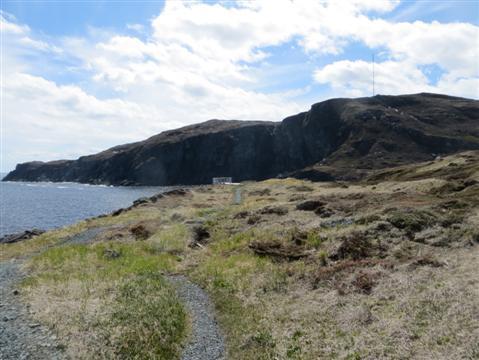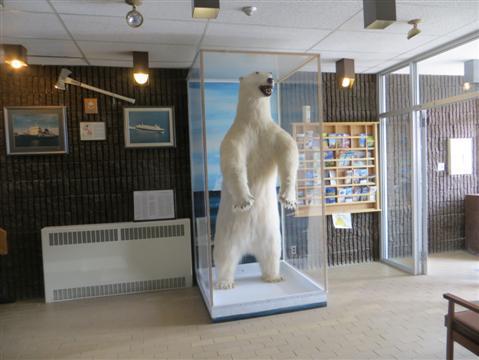About 1,000 years ago, some 500 years before Christopher Columbus's great-grandfather 25 times removed was even a glimmer in the eye of his great-grandfather 26 times removed, this now barren spit of land in the far north-west corner of Newfoundland welcomed the first known European to have landed in North America - Leif Eriksson, over on a joyride from Greenland.
Vinland site
It was warmer then and there were taller trees and more of them, which would have attracted the Vikings for boat building. The Icelandic sagas speak of the epic journey from Greenland but for centuries nobody could identify the spot where young Leif and his crew set foot in what they called Vinland, land of grapes, though there were certainly no grapes despite the greater warmth, and our illegal aliens doubtless quaffed copious amounts of home-brewed ale through their uplifted drinking horns instead of vintage wines d'Origine Contrôlée.
Speculation over the location ranged from Labrador to North Carolina. That is until 1960 when Norwegian explorer Helge Ingstad, joined later by his wife Anne Stine, came upon this site at L'Anse aux Meadows. A fisherman led them to what locals called an old Indian camp.
Ingstad bust
Here, in the overgrown remnants of trenches, Ingstad found the mound foundations of Norse sod buildings and a few unmistakeable items left by the Vikings such as nails and bolts, which the indigenous people did not have at that time.
Norse mound foundation
The physical description in the sagas of the the three lands seen - Helluland, Markland and Vinland - such as sandy shores and outer islands, fit Baffin Island, the coast of Labrador and L'Anse aux Meadows, and it is now generally accepted that this is indeed Vinland ground zero.
The Vikings, who were great traders, only stayed a decade or two. Relations with the locals were none too brotherly, with continual clashes, trading for furs and other native products were apparently not as rewarding as hoped, and the Norsemen returned back to whence they came.
Vinland today
If Leif Eriksson were to return today his first question might be: What in Valhalla's name is UNESCO? Vinland has been a UNESCO World Heritage Site since 1978.
He'd then gaze, perhaps in horror, first at his own statue, next at a red iron mock-up on a hillock of arriving Vikings, then at a modernistic sculpture showing two soaring iron thingies almost colliding, signifying the meeting of two worlds - the Norse coming from Europe and the indigenous people who had entered America from Siberia at least 14,000 years earlier.
The Vikings are coming
Two worlds meet
He'd note that the climate is colder now and the taller trees have gone from the spongey, springy fenland near the coast, replaced by sage green dwarf firs, some only two or three feet tall, and a host of tiny green plants similar to what you find in Iceland and Greenland.
He also might kindly explain why he chose the name Vinland. It seems that the Vikings did not sit pat in L'Anse aux Meadows, but travelled from this base further south, and wild grapes did indeed grow in New Brunswick.
Fortunately there are not many tourists on this particular day of Yours Truly's visitation. The site is indeed very evocative in its bleak beauty, a partially barren rocky moorland with huge icebergs floating out to sea in what is called Iceberg Alley, and blue-tinted pack ice littering the shore.
Iceberg Alley
There's a tasteful mock-up of a Viking sod house with a few attendants dressed as Vikings with their Norse ladies, making a fire and doing other Viking chores, and nearby are the grassy depressions of the actual site, typical of Norse sod houses, where Norse artifacts were found.
Viking sod house
Inside Viking sod house
Norse lady prepares her wool
Much to Yours Truly's surprise the site is not roped off and people are walking all over it. I at once accost a lady attendant, tarted up as Brynhildr (Brünnhilde for you Wagnerians) with prominent tin boob plates - the lady, that is, not Yours Truly - to express my concerns, to which she replies: 'Well, they've been here a thousand years, you know, and they're still alright.'
To which I snark: 'Well they won't be around another 1,000 days if you allow hordes of tourists to march all over them. Those depressions are going to need a psychotherapist; they're going to get very depressed indeed.'
Norse building depression
And another
She smiles meekly, lifts her skirt and scurries off along a boardwalk over the fen to a thoroughly modern loo. There's only so much period acting she's prepared to do.
Brynhildr
Now I know all of you are clamouring to know why L'Anse aux Meadows has a Franco-English hybrid name. It's all because the original name given by the French fishermen who for hundreds of years frequented the area was L'Anse à la Médée, Medea's Cove, Medea being quite a common boat name. English settlers then anglicised it in their own inimitable way.
While we're at it, there's another interesting name up here - Dark Tickle. And no, it doesn't mean a grope in the back row of the cinema. Tickle in Newfoundlandese means a very narrow strait.
Viking at the door
Viking powwow
Today, after days of heavy rain there's not a cloud in the sky, and the scenery is awe inspiring. The icebergs floating offshore flash blindingly white in all sorts of strange shapes, turning to fluorescent blue near the water. A couple look just like navy vessels. Others resemble towers or rugged crags. And that's just the exposed proverbial tip of the iceberg - 90 percent is under water.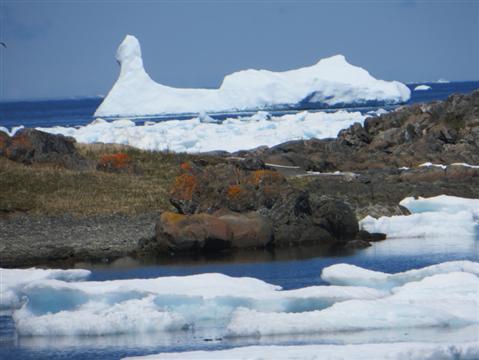
Huge iceberg passes close to shore
In the many picturesque coves and bays the wavelets sparkle silver in the glinting sun, the grass is pure emerald, the pines a darker shade of jade, and the ice packs hugging the shore glow with blue, affecting strange shapes, too. One looks like a three-legged table, others like artificial ice sculptures, yet others like mini icebergs.
Cove views
A few dozen miles down the cove-riddled eastern coast at the top of Newfoundland's Northern Peninsula is the French Shore. For 400 years, starting in 1504, doughty French fishermen from Normandy and Brittany braved all the perils that the howling tempests and mountainous waves of the north Atlantic could hurl their way to fish the cornucopia of cod that swarmed the seas every spring.
They set up little bases at Croque, Conche, Grandois and St. Julien with simple wooden houses on the grassy shore. Today these idyllic little hamlets still stand.
Croque cove
But the French no longer make that journey. Apart from the decimation of cod through overfishing, a little cross-Channel pact called L'Entente Cordiale in 1904 put an end to their trans-ocean fishing expeditions. In return for relinquishing its exclusive fishing rights in Newfoundland, France received an indemnity and territory in Africa in The Gambia and Nigeria.
Croque hamlet
The whole area has been declared a Canadian heritage site, and Newfies, as Newfoundlanders are called, many grotesquely obese, now fish these still generous waters that provide a cornucopia of lobsters - until they're almost fished to extinction as well.
Up close with the ice in Croque cove
There are magnificent views along the coast from atop the high cliffs in St. Anthony, the main town at the top of the Northern Peninsula and the self-proclaimed iceberg capital of the world. There's another magnificent view in the town hall, too - an enormous stuffed polar bear. He appeared one day in 1984 on a piece of pack ice, much to everybody's consternation, since this is not their territory and they are very aggressive, especially when hungry.
The shore from St. Anthony
But he died of natural causes before he could eat anybody, and they had him stuffed. Now standing in a glass case, he must be at least nine feet tall, and has huge hands, feet and claws.
St. Anthony's polar bear
Yikes! Over there, right by the road in Cape Onion, is a dirty great moose, very much alive, very unstuffed, and looking at Yours Truly very superciliously. It's a female, no antlers, but still very impressive. I stop the car and snap her from the window. She does a little skip and a dance, moves slightly further away, and again gives me that very superior look as if to say: 'You poor little git, you!'
Mademoiselle Moose at Cape Onion
Which is just about the way the frigging confusion-breeding Ford Fusion is looking at me. Dotted green lines are coursing up and down an indecipherable icon by the side of a fuel gauge, and the ruddy 'phone' is ringing again as the screen flashes, now in orange, 'Driver Alert Warning Rest Suggested.'
Well, I suppose that's better than yesterday's blood red 'Driver Alert Warning Rest Now.'
It's gimmickry gone crazy. I hate the car with a vengeance. I've taken to yelling at it. I loathe the musical symphony it plays, followed by two loud honks, every time I get out to take a photo without turning off the engine.
I curse it and tell to f... off, but to no avail. It doesn't even answer me back as Siri does.
Sunset over Gunners Cove
______________
By the same author: Bussing The Amazon: On The Road With The Accidental Journalist, available with free excerpts on Kindle and in print version on Amazon.

